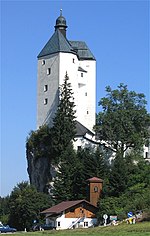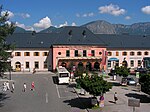The Battle of Wörgl or Wörgel was fought on 13 May 1809, when a Bavarian force under French Marshal François Joseph Lefebvre attacked an Austrian Empire detachment commanded by Johann Gabriel Chasteler de Courcelles. The Bavarians severely defeated Chasteler's soldiers in series of actions in the Austrian towns of Wörgl, Söll, and Rattenberg. Wörgl is located 20 kilometres (12 mi) south of the modern-day German border on the upper Inn River.
Civilian militia of the County of Tyrol rose in revolt under commander-in-chief Andreas Hofer supported by a strategic council at the start of the War of the Fifth Coalition. The hardy mountaineers rapidly banded together in irregular units and killed, captured, or routed the area's Bavarian and French garrisons. The patriot volunteering troopers were soon joined by Feldmarschall-Leutnant Chasteler's regular division sent from the Austrian Army of Inner Austria.
In mid-May, Lefebvre advanced on the Tyrol from the north and northeast with the Bavarian VII Corps. After the Bavarians mauled Chasteler's regulars at Wörgl, the Austrian general abandoned Tyrol and attempted to join with the retreating army in Hungary. The victory allowed the Bavarians to temporarily reoccupy Innsbruck, though not without additional fighting. The Tyrolean Civil Revolt, however, was far from over. Even after the regular Austrian armies met defeat at the Battle of Wagram in early July, the revolt resisted all efforts to stamp it out. The back of the rebellion was finally broken in November and only fizzed out in February 1810.











